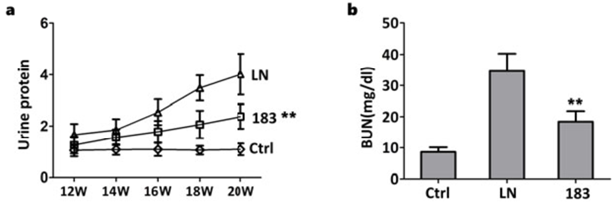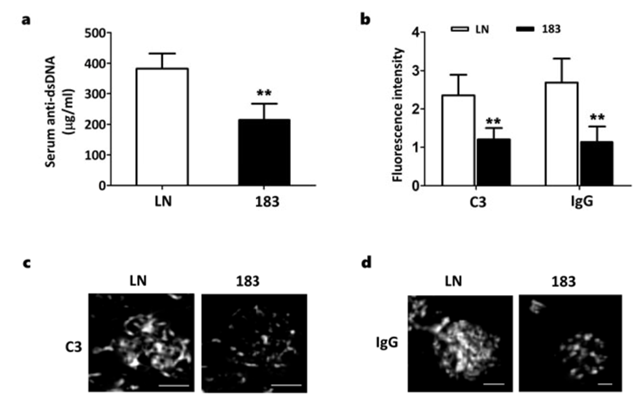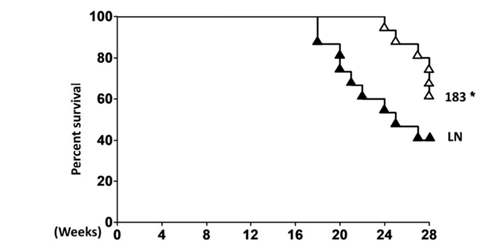MRL/lpr Mouse Model
MRL strain carrying a spontaneous mutation named lpr for lymphoproliferation is known as an autoimmune disorder that closely resembles human systemic lupus erythematosus (SLE). Both female and male MRL/lpr mice are characterized by systemic autoimmunity and immune complex glomerulonephritis and arthritis starting at about 10-12 weeks of age. In addition, this is a rapid and severe disease model compared with other spontaneous models. Creative bioarray provides you with MRL/lpr mouse model to study the genetic underpinning of SLE and test the efficacy of drug candidates targeting SLE.
Our capabilities
- We detect autoantibodies in animal serum by ELISA, Immunofluorescence, etc.
- We evaluate various cytokines through IHC, ELISA, etc.
- We identify Immunocyte subsets in spleens by flow cytometry.
Assays available
- PK/PD blood collections
- Quantitative detection of Anti-dsDNA and total IgG by ELISA
- Clinical chemistry analysis
- Histopathological evaluation
- Cytokine/chemokine analysis
- Flow cytometry in lymph nodes, spleen or bone marrow
- Organ weights (kidneys, spleen, lymph nodes)
- Survival rate
With outstanding experience in the field of SLE, we are confident to help you to overcome any upcoming challenges. Our experts are fully capable of customizing our protocols and assays to meet your specific needs. With our help, we wish to facilitate your research with high efficiency.
Study examples
 Figure. 1. miR-183 mimics reduces renal function in LN mice. MRL/lpr mice were received intraperitoneal injection with either miR-183 mimic (183 group) or miRNA-control (LN group) at a dose of 1 nmol per mouse twice per week from 12 weeks to 28 weeks of age. The sex- and age-matched C57BL/6 mice (Ctrl group) were used as a control group.
Figure. 1. miR-183 mimics reduces renal function in LN mice. MRL/lpr mice were received intraperitoneal injection with either miR-183 mimic (183 group) or miRNA-control (LN group) at a dose of 1 nmol per mouse twice per week from 12 weeks to 28 weeks of age. The sex- and age-matched C57BL/6 mice (Ctrl group) were used as a control group.
 Figure. 2. miR-183 mimics reduces serum anti-dsDNA antibody and renal deposition of
immune complex in LN mice.
Figure. 2. miR-183 mimics reduces serum anti-dsDNA antibody and renal deposition of
immune complex in LN mice.
 Figure. 3. miR-183 mimics increased the survival rate of LN mice.
Figure. 3. miR-183 mimics increased the survival rate of LN mice.
Quotation and ordering
If you have any special needs or questions regarding our services, please feel free to contact us. We look forward to cooperating with you in the future.
Reference
Li X et al. MiR-183 delivery attenuates murine lupus nephritis-related injuries via targeting mTOR. Scand J Immunol. 2019 Jul 20.
For research use only. Not for any other purpose.
Disease Models
- Oncology Models
-
Inflammation & Autoimmune Disease Models
- Rheumatoid Arthritis Models
- Glomerulonephritis Models
- Multiple Sclerosis (MS) Models
- Ocular Inflammation Models
- Sjögren's Syndrome Model
- LPS-induced Acute Lung Injury Model
- Peritonitis Models
- Passive Cutaneous Anaphylaxis Model
- Delayed-Type Hypersensitivity (DTH) Models
- Inflammatory Bowel Disease Models
- Systemic Lupus Erythematosus Animal Models
- Oral Mucositis Model
- Asthma Model
- Sepsis Model
- Psoriasis Model
- Atopic Dermatitis (AD) Model
- Scleroderma Model
- Gouty Arthritis Model
- Carrageenan-Induced Air Pouch Synovitis Model
- Carrageenan-Induced Paw Edema Model
- Experimental Autoimmune Myasthenia Gravis (EAMG) Model
- Graft-versus-host Disease (GvHD) Models
-
Cardiovascular Disease Models
- Surgical Models
- Animal Models of Hypertension
- Venous Thrombosis Model
- Atherosclerosis model
- Cardiac Arrhythmia Model
- Hyperlipoidemia Model
- Doxorubicin-induced Heart Failure Model
- Isoproterenol-induced Heart Failure Model
- Arterial Thrombosis Model
- Pulmonary Arterial Hypertension (PAH) Models
- Heart Failure with Preserved Ejection Fraction (HFpEF) Model
-
Neurological Disease Models
- Alzheimer's Disease Modeling and Assays
- Seizure Models
- Parkinson's Disease Models
- Ischemic Stroke Models
- Acute Spinal Cord Injury (ASCI) Model
- Traumatic Brain Injury (TBI) Model
- Hypoxic-Ischemic Encephalopathy (HIE) Model
- Tourette Syndrome (TS) Model
- Amyotrophic Lateral Sclerosis (ALS) Model
- Huntington's Disease (HD) Model
- Intracerebral hemorrhage (ICH) Models
- Schizophrenia Model
- Pain Models
-
Metabolic Disease Models
- Type 1 Diabetes Mellitus Model
- Type 2 Diabetes Mellitus Model
- Animal Model of Hyperuricemia
-
Nonalcoholic Fatty Liver Disease Model
- High-Fat Diet-Induced Nonalcoholic Fatty Liver Disease (NAFLD) Model
- Methionine and Choline Deficient (MCD) Diet-Induced Nonalcoholic Fatty Liver Disease (NAFLD) Model
- Gubra-Amylin NASH (GAN) Diet-Induced Nonalcoholic Fatty Liver Disease (NAFLD) Model
- Streptozotocin (STZ) Induced Nonalcoholic Fatty Liver Disease (NAFLD) Model
- High Fat Diet-Induced Obesity Model
- Diabetic Foot Ulcer (DFU) Model
- Liver Disease Models
- Rare Disease Models
- Respiratory Disease Models
- Digestive Disease Models
-
Urology Disease Models
- Cisplatin-induced Nephrotoxicity Model
- Unilateral Ureteral Obstruction Model
- 5/6 Nephrectomy Model
- Renal Ischemia-Reperfusion Injury (RIRI) Model
- Diabetic Nephropathy (DN) Models
- Passive Heymann Nephritis (PHN) Model
- Adenine-Induced Chronic Kidney Disease (CKD) Model
- Kidney Stone Model
- Doxorubicin-Induced Nephropathy Model
- Orthotopic Kidney Transplantation Model
- Orthopedic Disease Models
- Ocular Disease Models
- Skin Disease Models
- Infectious Disease Models
- Otology Disease Models